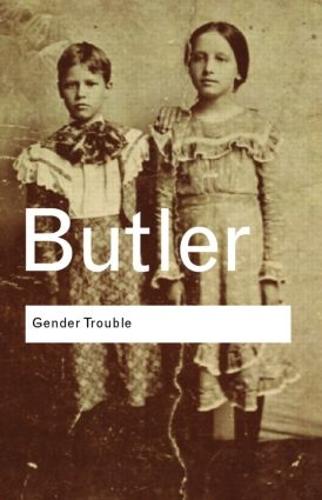Judith Butler describes gender as “ an identity instituted through a stylized repetition of acts ”. In other words, it is something learnt through repeated performance
How useful is this idea in understanding gender is represented in both the Score and Maybelline advertising campaigns?
Most people believe gender is distinguished as just male and female however Butler says that it is played out and sometimes that causes misrepresentation like in the score advert women are sexualised and objectified however in the maybelline “boss up” advert there is a variety of identities. Butler is a gender theorist and says that gender is a performance where everyone is performing their own gender and that it’s a fluid of identity which David Gauntlett coined for his own. The use of identity isn’t based upon gender and I am going to discuss the representation of gender and identity in the Score and Maybelline adverts.
In contrast to Butler, Laura Mulvey identifies the sexualisation of femininity and female characters compared to the male character that we identify with due to the lack of sexualisation and the addition of development and characteristics shown to deepen their character, in a lot of games and movies, Mulvey stated female characters are forced to identity with passive objects to be looked at and desired compared to men’s representation which is more focussed on how the characters body language reinforces the features they have- e.g. an assassin moving sneakily. She also has the idea that the majority of movie directors, game developers, big artists and key people in the media are men therefore we view media in a mans view hence the male gaze, an example would be in a film panning the camera on a sexualised female scene or in a media game exaggerations of female body parts overlooking how they’re actually meant to walk to show more depth to the character. This doesn’t mean male characters can’t be sexualised either- there’s just a stronger amount of female sexualisation- someone replaced popular oversexualised female poses with a boy doing it but that would still be viewing it in the male gaze. The male gaze supports the idea that a sexualised way of looking empowers men and sexualised women.
The Score hair cream advert is an historical artefact from 1967, as such it can be examined productively by considering its historical, social and cultural contexts, particularly as it relates to gender roles, sexuality and the historical context of advertising techniques. 1967 can be seen as a period of slow transformation in western cultures with legislation about and changing attitudes to the role of women and men in society, something that the advert can be seen to negotiate. The first wave of feminism can be described with a quotation ‘ sexism was coined by analogy with the term racism in the American civil rights movement in the early 1960s. Defined simply, sexism refers to the systematic in which men and women are brought up to view each other antagonistically, on the assumption that the male is always superior to the female. The Score advert can be similarly linked to this idea because we can see a total of five female figures holding up the male figure giving us the assumption that the male is superior to the females.
In addition, the idea of fluidity of identity by Gauntlett Fluid of identity is having the choice to change the way you come across however you like. If you don’t want to look a certain way, fluidity of identity creates the meaning of being able to change that and change how you perceive yourself as a person. Not only that Fluid of identity also means having the fluidity to change the way you act to something favoured or to something which can be categorised as normal. Fluid of Identity is the freedom to change who you are as a person from how you look to how you act if you prefer to-do that.. For instance, gender is fluid, you can have the choice who to identify as. This supports Butler’s theory, who quotes “ Biological anatomies do not determine our gender”. She concludes that masculinity and femininity are not naturally given states, but instead are maintained by individuals through everyday acts meaning that an individual is not born neither male nor female, however your gender defines you through your actions everyday. Gauntlett commented on the changing of representation of men and women in mainstream media. For example the depiction of the passive housewife throughout the twentieth century was being increasingly replaced by images of assertive women taking control of their lives, epitomised by the “girl power” endorsed by the Spice Girls. The representation of men being active and confident was giving way to a more introspective and emotionally aware version of masculinity. Despite the old binary representations still finding their way to the front covers of magazines, now there is a “great diversity of identities”. In this way, we do not always have a fixed identity because we are willing to adapt to new cultural norms.
This theory is not implied in the score advert, however it can be seen in the more contemporary modern advert from Maybelline, this is because in the Maybelline “boss up” advert we can assume the representation of the female gender has adapted over time, we can make this assumption due to the reason that the gender roles are are suggested to be more equal. Within the advert you can see a homosexual male celebrity with what is thought to be feminine characteristics, also in the advert there is also a female character who is depicted up feel like a “boss” after using the product, this is found towards the end of the advert. This can dispute the idea that there are fixed gender roles and the historical idea that men are superior to women. The theory of raunch culture is also demonstrated in this advert due because the female character is not being sexualised in any way within the advert. “Raunch culture is the sexualised performance of women in the media that can play into male stereotypes of women as high sexually available.
The maybelline advert is seen to demonstrate the third and fourth wave of feminism. Third wave feminism was coined by Naomi Wolf as a response to the generation gap between the feminist movement of the 1960s and 1970s, challenging and re-contextualsing some of the definitions of femininity that grew out. It saw women’s lives as intersectional and demonstrated a pluralism towards race, ethnicity, class, religion, gender and nationality when discussing feminism. It can be described as the ‘rebellion of younger women against what was perceived as the prescriptive, pushy and ‘sex negative’ approach of older feminists. This concept is demonstrated by the Maybelline advert because of the female representation within the advertisement is not being sexualised or objectified in any way meaning that she opposes the stereotype of what the first wave of feminism suggests what it means to be a ‘female’.
In conclusion, I believe that Butler’s description of gender as “ an identity instituted through a stylized repetition of acts ” helps people to comprehend how gender is represented to a more clear extent in the Maybelline advert in comparison to the score advert due to the fact that the score hair cream advert opposes the idea that gender is not determined by biological genders.



